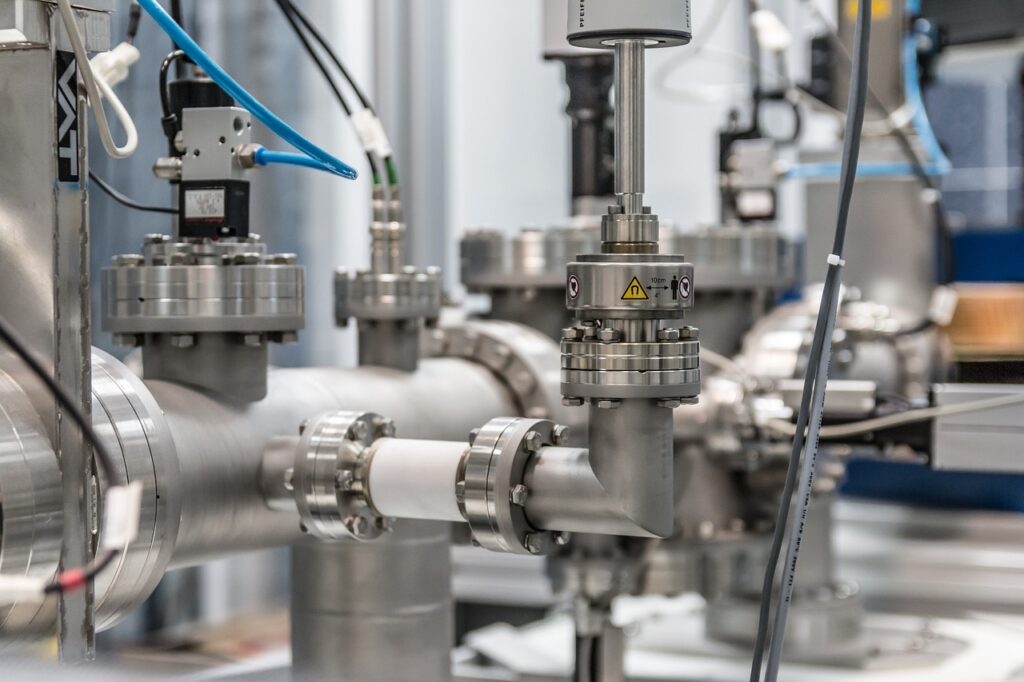Steel is typically a high-strength and durable material. They may have a wide range of varieties based on different applications. Carbon steel pipe is one of the most popular items used in construction. Besides, we may also see its application in heavy vehicles, like oil, food, and cement transportation. Because of the remarkable advantages of carbon steel pipes, they are prevalent in a wide range of applications. In today’s article, we will talk about those properties & applications.
We will begin by understanding the fundamental properties of carbon steel pipes. Following this, we will discuss some of its actual applications. In addition, it is also crucial to understand the difference between carbon steel and stainless steel. We will learn their distinctive properties & applications. Finally, we will discuss some tips on choosing the right CS pipe. So, this discussion is going to be a comprehensive guide on carbon steel pipe.
What is a Carbon Steel Pipe?
A metal pipe made of carbon steel is called a carbon steel pipe. It is a tubular structure primarily composed of iron & carbon. The combination of these two materials contributes to its distinct properties. However, based on different applications, the properties and application of carbon steel pipe may also vary.
The primary purpose of carbon steel pipes is to convey fluids, gases, and other materials. In some cases, CS pipes are also used in construction for structural purposes. Carbon steel’s robust construction ensures the integrity of the conveyed substances. As a result, the carbon steel pipe became an indispensable infrastructural element in the project.
Properties of Carbon Steel Pipe
Carbon steel comes in a wide range of varieties. The types of CS steel grades may also vary based on different material compositions. However, these grades have distinct properties that make them suitable for specific applications. Let’s explore how these changes in material composition alter the properties of carbon steel pipes.
Material composition
The material composition of carbon steel determines its mechanical & chemical properties. These compositions influence carbon steel’s suitability for various applications. The composition mainly includes iron & carbon. However, they may also contain alloying elements such as manganese, silicon, sulfur, and phosphorous. The following table represents the general composition of some examples of typical CS pipe materials. Note that the value of different material content may vary based on different grades and standards.
| CS Pipe | Example | Iron | Carbon | Manganese | Phosphorous | Silicone |
| Low | A36 | 98% | 0.25% | 1.03% | 0.04% | 0.28% |
| Medium | 1040 steel | 98.6% | 0.4% | 0.9% | <0.05% | <0.04% |
| High | 1095 steel | 98.4% | 0.95% | 0.5% | <0.05% | <0.04% |
Physical Properties
Carbon steel provides various physical properties that contribute to their varying utility. These include density, thermal, and electrical conductivity. These properties vary across different grades. It also influences the material’s suitability for specific applications. The density provides insight into the overall weight and strength of the pipe. Thermal conductivity affects its performance in varying temperature environments. Moreover, electrical conductivity typically measures the carbon steel’s ability to conduct electric current.
For a comprehensive comparison, check out the table below. It highlights the distinctions in physical attributes among common grades of carbon steel. There are three typical grades of carbon steel. They are low-carbon, medium-carbon, and high-carbon steel. Let’s check out their numbers.
| Physical Constraints | Low Carbon Steel | Medium Carbon Steel | High Carbon Steel |
| Density (lb/in³) | 0.103 – 0.292 | 0.280 – 0.285 | 0.0163 – 0.298 |
| Thermal Conductivity (BTU-in/hr-ft²-°F) | 176 – 645 | 152 – 361 | 132 – 361 |
| Electrical Conductivity | 15 – 20 (% IACS) | 15 – 20 (% IACS) | 15 – 20 (% IACS) |
Mechanical Properties
A carbon steel pipe’s mechanical properties determine its performance under various conditions. These include tensile strength, yield strength, fracture toughness, shear modulus, and melting point. Tensile strength measures the material’s resistance to a force pulling apart. On the other hand, yield strength indicates the stress at which the material deforms permanently.
Moreover, fracture toughness measures carbon steel’s resistance to brittle fracture. Simply, it’s the ability to withstand the propagation of cracks. Sheer modulus measures carbon steel’s resistance to deformation under shear stress. Finally, the melting point of carbon steel is the temperature range at which it starts to melt. Let’s check out these numbers in the following table.
| Mechanical Constraints | Low Carbon Steel | Medium Carbon Steel | High Carbon Steel |
| Tensile & Yield Strength | 20300 – 347000 psi | 35500 – 252000 psi | 39900 – 484000 psi |
| Fracture Toughness | 30.0 – 105 ksi-in½ | 73.7 – 130 ksi-in½ | 12.0 – 150 ksi-in½ |
| Shear Modulus | 10200 – 11600 ksi | 10400 – 11900 ksi | 11300 – 12000 ksi |
| Melting Point | 2600°F | 2597– 2800°F | 2,800-2,900°F |
Types of Carbon Steel Pipe
The classification of carbon steel pipe is necessary to distinguish the different purposes of each type. For example, welded carbon steel pipe can not fulfill the prime objective of seamless carbon steel pipe. Therefore, this division provides an understanding of the various forms of carbon steel pipe. It also highlights their specific applications. Based on distinct manufacturing processes & functionality, we found three types of CS pipes.
- Seamless carbon steel pipes are made through a continuous manufacturing process. There are four types of steel pipe fabrication process. They are mandrel mill, Mannesmann plug, forged, and extrusion manufacturing process for seamless. Seamless carbon steel pipes provide enhanced strength. They are mostly suitable for high-pressure applications.
- Welded carbon steel pipes are also made through four major welding manufacturing processes. They are ERW, EFW, HFW & SAW. Welded carbon steel pipes are cheaper than Carbon seamless steel pipes. But they can’t provide strength like seamless carbon steel pipe.
- Galvanized carbon steel pipes undergo a coating process. This process involves applying a layer of zinc to protect the steel from corrosion. This extra layer of coatings offers superior corrosion resistance.
Application of Carbon Steel Pipe
Because of carbon steel pipe’s versatility & reliability, they are famous in various industries. They typically serve as the backbone of essential infrastructure. In construction, they are widely used for structural support & fluid transport. These pipes are crucial in plumbing, water supply, and wastewater disposal systems.

Moreover, carbon steel tubes are also prevalent in the oil & gas industry. In this sector, they are used in the pipelines for transporting crude oil & natural gas. Besides, steel carbon pipes facilitate the conveyance of raw materials in manufacturing industries. Thus, they provide stability & reliability in power generation, chemical processing, and infrastructure construction. It makes carbon steel pipes an essential component in diverse industrial applications.
Carbon Steel vs Stainless Steel
Carbon and stainless steel are popular construction equipment used in many industries. Each of these materials offers unique advantages and applications. The following table will teach the fundamental differences between a stainless and carbon steel pipe.
| Property | Steel carbon pipe | Stainless Steel Pipe |
| Composition | Primarily iron and carbon with trace elements | Iron, chromium, nickel, and varying alloying elements |
| Corrosion Resistance | Susceptible to corrosion, especially in harsh conditions | Excellent corrosion resistance, suitable for harsh environments |
| Tensile Strength | Generally lower than stainless steel | Higher tensile strength, providing greater structural integrity |
| Cost | Typically more economical | Higher cost due to alloying elements and manufacturing process |
| Weldability | Generally good weldability | Some grades may require specialized welding techniques. |
| Magnetic properties | Typically magnetic | Depends on the specific grades; some are non-magnetic |
| Applications | Commonly used in various industries for general purposes | Widely used in industries requiring corrosion resistance (Chemical, food, medical) |
How to Choose the Right Carbon Steel Pipe
Selecting the right carbon steel pipe is a critical decision. It involves a thorough evaluation of various factors. You know, all these factors contribute to the optimal performance and durability of a specific application.
- Project Requirements: First, you must evaluate your project requirements. In this case, you can assess pressure, temperature, and the type of conveyed substances. These factors determine the appropriate grade, size and type of carbon steel pipe.
- Environmental factors are also essential to consider. You know, exposure to corrosive elements, extreme temperatures, or atmosphere is noteworthy in this case. These factors are necessary when using certain grades or coatings. Indeed, the right choice enhances durability and corrosion resistance.
- Industry Standards guarantee that the chosen pipe meets safety, quality and performance requirements. It also provides confidence in its suitability for the intended application.
- Budget: You can evaluate budget constraints and balance them with the desired quality & performance. Different grades & types of carbon steel tubes come with varying costs. So, finding the right balance ensures cost-effectiveness without compromising functionality.
- Consulting experts & engineers can provide valuable insights. It helps select the most suitable carbon steel pipe based on their experience and knowledge.
Summary
Let’s wrap everything up! Carbon steel pipe is a popular type of steel production. The carbon content in these materials typically divides them into three primary grades. They are low, medium and high-carbon steel. Due to this varying carbon content, the properties of each grade also vary. We have listed them in brief already.
Moreover, we have gone through different types of carbon steel pipes. They are seamless, welded and galvanized carbon steel pipe. Each type offers unique advantages and applications. Besides, we also learned the fundamental differences between stainless and carbon steel tubes. At the end, we discussed choosing the right carbon steel pipe for your project. So, we hope this article gives you sufficient knowledge of carbon steel pipes. For more information, feel free to contact us.
